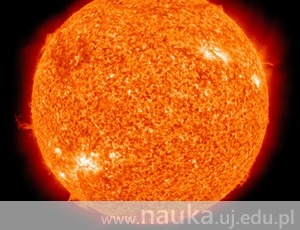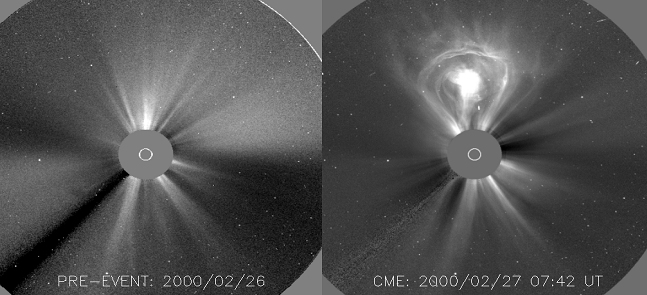
Can we predict the weather in space? Do we know what influences it? And how does it affect us? We asked Dr hab. Grzegorz Michałek from the JU Astronomical Observatory.
Life on Earth is entirely dependent on the Sun. For many of us, it seems to be an unchanging, perhaps even a little boring astronomical object – after all, it has stayed the same for thousands of years. However, even the first observations made by primitive telescopes have shown that darker spots sometimes appear on the Sun’s surface. As it turns out, this phenomenon recurs in cycles, reaching its apex every eleven years or so. We’ve always thought that these spots have no effect on our lives – and we were wrong.
The Sun ‘shines’ at night
11 September 1859, a cloudless noon. While observing the Sun, British astronomer Richard Carrington witnessed a strange phenomenon which lasted about five minutes. Two bright lines appeared around sunspots. That very night, Earth’s skies were filled with red, green and purple lights. Many reports from around the world described strange fluctuations of Earth’s magnetic field. Carrington did not only see an eruption on the surface of the Sun, but also keenly predicted its effect on our planet. He was the first to suggest that the Sun also affects Earth during the night.
Cosmic weather is a branch of knowledge devoted to studying the Sun’s influence on our planet. It's focused on all phenomena that can disturb our satellites, pose a threat to astronauts in space, and disrupt the technologies we use on Earth.
Cosmic weather is entirely determined by the eruptions on the Sun. There are two types of those: solar flares and coronal mass ejections. During a flare, parts of solar atmosphere reach temperatures comparable to those in the Sun’s core (almost 10 million °C). This is accompanied by a strong emission of electromagnetic radiation in the entire spectrum. However, coronal mass ejections are definitely the more important ones. For the last several decades they’ve been a subject of intense research aimed to give us more insight into cosmic weather prediction. It’s essentially the same process as predicting the weather on Earth’s surface, though naturally involving analyses of much different parameters and phenomena.
Coronal mass ejections
The energy in the Sun’s corona can be classified into three types: thermal, gravitational and magnetic. And yet, only the energy amassed in the form of electromagnetic field can sate the coronal mass ejections’ hunger for energy. They cause massive fragments of the corona to fly out into space, reaching incredible speeds (the fastest ever recorded travelled with the speed of 3,000 kilometres per second).
We’re sure that coronal mass ejections are powered by electromagnetic fields, but we’re not sure about the details of the process. It’s speculated that they happen due to losses of stability of the magnetic fields, emitted constantly by the Sun. The strongest magnetic fields cause the formation of dark spots. The magnetic field is subject to tension, much like the string of a bow, and sometimes the tension is so high that it causes loss of stability. In such cases, we’re talking about magnetic reconnection. A sudden eruption releases energy stored in the magnetic field, ejecting giant magnetic clouds into the interplanetary space, while high temperature plasma generates a surge in various emission, in particular of UV rays and X-rays.
Danger! Charged particles are on their way
Coronal mass ejections can affect Earth in two ways. Firstly, they generate shockwaves which accelerate charged particles (electrons, protons, alpha particles, helium nuclei) to amazing speeds. These particles reach us in about 20 minutes after the eruption, and they may continue to bombard Earth for as long as several days.
Such phenomena have an adverse effect on satellites, destroying them or destabilising their systems. Charged particles ionise the upper layers of the Earth’s atmosphere, resulting in disrupted communication. Naturally, Earth’s own magnetic field prevents the particles from directly affecting the planet’s surface. Only particles possessing electrical charges larger than 1 GeV (gigaelectronvolt – 109 electronvolts) can reach Earth’s surface. However, such instances are very rare.

Another factor that shapes cosmic weather is the shockwaves. They reach Earth later than the particles they propel – they need between 1 and 4 days. Although it’s easier to predict their arrival, their impact on our planet is much more severe, especially if the magnetic field carried by the coronal mass ejection faces the opposite direction from the one emitted by Earth. In such cases, Earth magnetic field annihilates with the one carried by the shockwave, thereby losing its protective function and allowing particles from outer space to reach Earth. This is called a geomagnetic storm. Scientists estimate that we can expect about one such storm per month. Its only positive result is the beautiful lights appearing near Earth’s poles, as the protection is there is at its weakest.
Scientists also talk about the Sun’s impact on climate. Some research studies show it may be responsible for the Little Ice Age – a period in 16th–19th century, during which the average temperature on the Northern Hemisphere fell by about 1 °C, resulting in longer winters, bigger glaciers etc.). This was correlated with the Sun’s lower magnetic activity.
Another problem caused by geomagnetic storms is the threat of mass power outages. In 1989, after a large scale coronal mass ejection, an overload of electrical network in Quebec caused a 9-hour break in power supply.
Coronagraphs in action
Coronal mass ejections are a recently discovered phenomenon. They were first detected in 1971. The corona (the highest layer of solar atmosphere) has a very low density and is much less visible than photosphere (the visible layers of solar atmosphere). Therefore, we can observe the corona only during solar eclipses or using special satellite telescopes called coronagraphs, which have diaphragms that obscure the bright halo.
A major breakthrough in coronal mass ejection study was the Solar and Heliospheric Observatory mission. This satellite has been monitoring the Sun for twenty years. It’s equipped with two coronagraphs capable of investigating the corona from different ranges that have since captured over 30 thousand ejections. All of them have been studied, described and catalogued at the SOHO/LASCO website – an effort in which Dr Grzegorz Marek was able to participate. It allowed scientists to determine that during maximum solar activity, as much as ten coronal mass ejections can occur in a week.
Original text: www.nauka.uj.edu.pl





